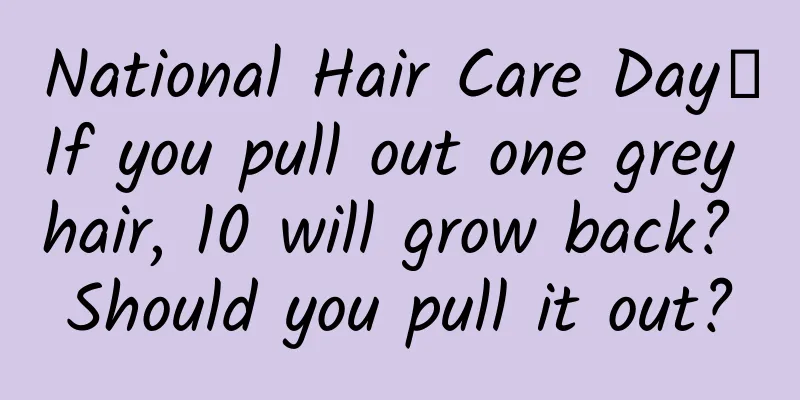National Hair Care Day丨If you pull out one grey hair, 10 will grow back? Should you pull it out?

|
"If you pull out one grey hair, 10 will grow back?" There is a rumor that white hair cannot be pulled out, because if you pull it out, 10 more hairs will grow. Is this true? Rumor Analysis This statement is incorrect. Each hair has its corresponding follicle. The melanin in each follicle will act on the hair produced by this follicle. Even if the white hair is pulled out, the number of follicles will not increase, and more white hair will not grow. I believe someone around you has said this: Don't pull out your white hair, because the more you pull out, the more hair you will grow. How many more hairs will you grow? Some people say that if you pull out one hair, three will grow. Some people even say that if you pull out one hair, 10 will grow. Is this really true? Of course not! If that were true, dermatologists would probably wake up laughing in their dreams, because people with hair loss can be saved! Just imagine, 1 becomes 10, 10 becomes 100... If you keep pulling out the hair, there will be more and more, and hair loss will no longer be a medical problem that bothers us. Curious readers may still have many questions that have not been clarified, such as why white hair is indeed difficult to remove completely, how white hair is formed, and how to deal with white hair. Today is National Hair Care Day. Let’s talk about the gray hair that troubles everyone. Why can’t we completely remove all the white hair? Some people mistakenly think that if white hair grows back after being plucked, it is a problem with the pluck. In fact, it is not. If you do not pluck the hair, new white hair will often continue to grow. Why is this happening? A very common reason is age . It's not that we have reached old age, but that we are just older than before. Let's look at a few sets of data: White people generally start to get gray hair around the age of 35, Asians generally start to get gray hair in their 30s to 40s, and black people start to get gray hair around the age of 45. In addition, half of the people will have a lot of gray hair by the time they are 50 years old. Therefore, if the number of white hairs gradually grows after the age of 30, it is generally a natural phenomenon as mentioned above, and it is not surprising . This is the same reason why our skin is no longer tender, fine lines appear around the eyes, and spots appear on the cheekbones. The mechanism of this kind of hair turning white is that the melanocytes in the hair follicles are not active enough to produce normal melanin, so the hair that grows out is no longer black. If you look closely, some hair is gray and some is white. Gray hair has less pigment, while white hair has no pigment at all. Copyrighted stock images, no reproduction is authorized Moreover, if someone in the family has similar white hair, then through inheritance, it will also affect the offspring to a certain extent. In other words, this situation of insufficient melanocyte activity has a certain genetic tendency. In addition, a small number of people will have premature gray hair. The definition for Asians is to have more than 5 gray hairs before the age of 25. This situation is not uncommon. If this premature gray hair is not widespread and does not continue to worsen, there is usually no need to worry too much. Why does premature graying of hair occur? Scholars speculate that it may be related to a number of factors, such as: Environmental factors: UV exposure from sunlight Personal behavior: smoking, the effects of certain drugs Nutritional factors: trace element deficiency, nutrient deficiency Disease factors: vitiligo, thyroid disease Readers who have premature gray hair can compare and contrast. If the premature gray hair is widespread or even getting worse, you can seek medical attention in time and ask a dermatologist to assist in the evaluation. Should I pluck my white hair or not? Although pulling out white hair will not make it grow more, it is still a question of whether to pull out white hair or not. From a medical point of view, it can be removed, but there are risks. The reason why you can pull out the hair is that if you pull out one hair, there will be one less hair. If the hair follicle is damaged, then the corresponding hair follicle will not be able to produce white hair anymore. But the risk is that after the hair follicles are damaged, there is a certain probability of infection, such as bacteria taking advantage of the opportunity to enter the scalp and causing bacterial folliculitis, which manifests as small white or red particles and pustules in the center of the hair follicles. If there are a lot of white hairs, the operation is also troublesome, and the pain of pulling out the hair and the probability of infection will be superimposed. Therefore, whether to pull out or not is not a factual judgment but a value judgment. There is no standard answer and you have to weigh it yourself. So, if you don't want to pull it out, are there any other ways? Answer: There are many ways. Method 1: Leave it alone. Seriously speaking, this is indeed a method. We need to know that no one is perfect, and the same is true for skin. Hair will turn white, skin will become rough, wrinkles will increase... If you can follow the changes of nature, it is not a bad idea (and it can save money and worry). Method 2: Cut off the white hair at the root. This is to cut off the white hair at the root. This has the advantage of not damaging the hair follicles and not worrying about folliculitis; but it also has the disadvantage that the white hair will appear again after a while - specifically, it will grow about 1.3 cm in 1 month. Method 3: Dyeing your hair. Dyeing your hair is a good way to quickly improve your appearance. It is also a solution recommended by doctors and is suitable for middle-aged and elderly people with a lot of white hair. What about medication? Unfortunately, there is no proven effective drug that can turn grey hair black. What should I do if I don’t want to have gray hair? Unfortunately, there is no good way to prevent it. Scientists have conducted experiments on mice and found that there are three genes that can help maintain the number of melanocytes. By manipulating these genes, they successfully prevented or reduced gray hair in mice. However, there are currently no products based on this research. Some studies have shown that smoking is more likely to cause gray hair. The specific data is this: among smokers, the probability of having gray hair before the age of 30 is 2.5 times that of non-smokers. So if you don't want to have gray hair, long-term smokers can try to quit smoking. Copyrighted stock images, no reproduction is authorized If you sleep well and live happily every day, will you have fewer white hairs? The answer is "uncertain", because there is no definite relationship between stress, emotional problems and white hair. Most white hair and stress are two different things. It can be seen from this that trying to avoid gray hair is mostly futile. Similarly, Diana Jewell, author of Going Gray, Looking Great, admits, “It’s far from true that gray hair makes you look older. If you were young, vibrant, and healthy before your hair got gray, you’ll still be young, vibrant, and healthy after your hair got gray. It all depends on your attitude toward it… If you think of it as just another color, you won’t be afraid of graying.” “Accept what we cannot change” is also suitable for those of us with gray hair. Looking in the mirror of rumors Rumors like "Pulling out one white hair will cause 10 to grow" are actually our anxiety about aging. In the face of aging, what we can do is to accept the arrival of the first white hair with a positive attitude, and welcome the arrival of more white hair with a more tolerant attitude. References [1] El-Sheikh AM, Elfar NN, Mourad HA, et al. Relationship between trace elements and premature hair graying. Int J Trichology. 2018; 10(6): 278-283. [2] Premature graying: reasons, options. https://www.webmd.com/beauty/features/abcs-premature-graying [3] Why hair turns gray. https://health.clevelandclinic.org/why-hair-turns-gray [4] Why does hair turn gray? https://www.health.harvard.edu/blog/hair-turn-gray-2017091812226 [5] William L. Weston MD, et al. Structure and function of the skin. Color Textbook of Pediatric Dermatology (Fourth Edition). 2007. Planning and production Author | Tang Jiaoqing, attending physician of dermatology, doctor of medicine, popular science author Review | Feng Jun, deputy chief physician of the Dermatology Department of Sinopharm Tongmei General Hospital Planning | Fu Sijia Editor: Fu Sijia Proofread by Lin Lin The cover image and the images in this article are from the copyright library Reprinting may lead to copyright disputes |
<<: Before traveling into space, why not learn some vegetable-growing skills?
Recommend
Understand the framework system of event operation in 10 minutes
Activities are a booster for any product. Good ac...
Color TV industry is frozen, foreign brands' market share has achieved "three consecutive jumps"
The color TV industry not only had a cold start t...
Monkeypox virus has spread to many countries. Why is it so scary?
Mixed Knowledge Specially designed to cure confus...
Train tickets for the first day of the Dragon Boat Festival holiday are on sale today. Travel healthily and do not relax your efforts in epidemic prevention.
Dragon Boat Festival is coming This Friday will s...
It turns out that physicists really eat Chinese food every Friday! Sheldon is not lying to me
On July 4, 2012, the European Organization for Nu...
How to make money by posting videos on Xigua Video? How to make money by shooting Xigua videos?
There are many mobile phone apps on the Internet ...
A Raspberry Pi with Windows 10 is still $35
Raspberry Pi, which "sticks to the $35 price...
When "National Hypertension Day" meets Cold Dew, how can we get through it smoothly?
Author: Liu Machao Department of Cardiology, Xuan...
Methodology in the Internet Age: Business Rules for Online Communities
Since the development of the Internet, people hav...
How did the only city in China named after "flower" achieve a hardcore counterattack?
It is the 60th anniversary of Panzhihua's dev...
How to establish the standard requirements for B-end products? I have summarized five aspects!
In recent days, I have been sorting out matters r...
Xiaohongshu brand promotion: the secret to triple ROI!
I see that brand partners have deviations in the ...
One drop of water generates six times of electricity! The world's largest clean energy corridor "Industrial Brain" is basically completed
The six large hydropower stations of Wudongde, Ba...
Are frequent small earthquakes a precursor to larger earthquakes? Can Mabaloxavir prevent influenza? Here comes the list of scientific rumors in January 2025 →
1.Do frequent small earthquakes indicate a major ...
Review of the new toy for geeks: Baofeng Magic Mirror 3 plus
At this year's E3 exhibition, Microsoft's...









